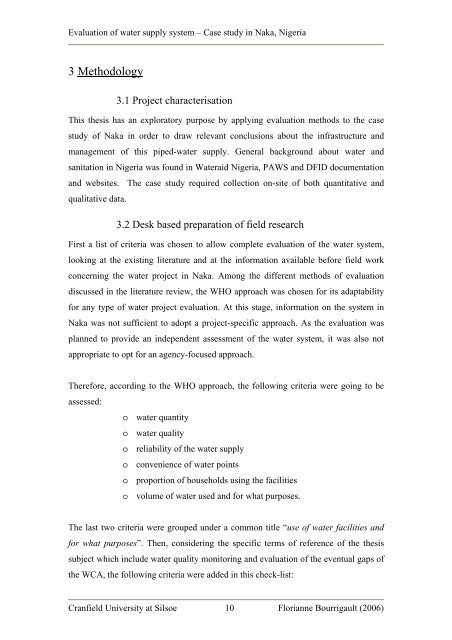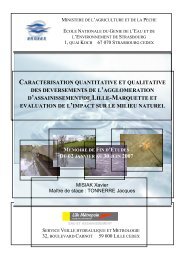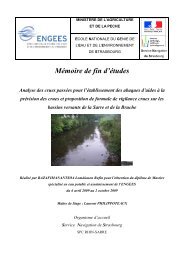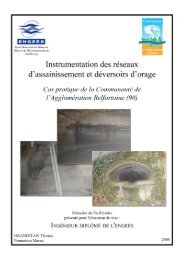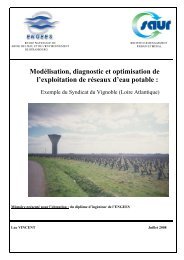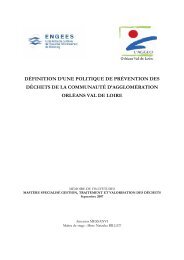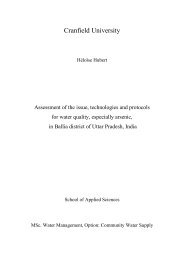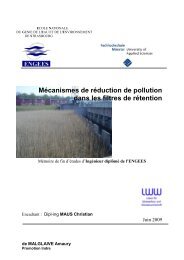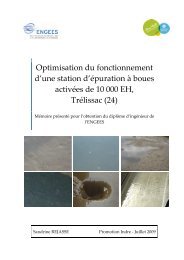Evaluation of water supply system Case study in Naka ... - ENGEES
Evaluation of water supply system Case study in Naka ... - ENGEES
Evaluation of water supply system Case study in Naka ... - ENGEES
- No tags were found...
Create successful ePaper yourself
Turn your PDF publications into a flip-book with our unique Google optimized e-Paper software.
<strong>Evaluation</strong> <strong>of</strong> <strong>water</strong> <strong>supply</strong> <strong>system</strong> – <strong>Case</strong> <strong>study</strong> <strong>in</strong> <strong>Naka</strong>, Nigeria3 Methodology3.1 Project characterisationThis thesis has an exploratory purpose by apply<strong>in</strong>g evaluation methods to the case<strong>study</strong> <strong>of</strong> <strong>Naka</strong> <strong>in</strong> order to draw relevant conclusions about the <strong>in</strong>frastructure andmanagement <strong>of</strong> this piped-<strong>water</strong> <strong>supply</strong>. General background about <strong>water</strong> andsanitation <strong>in</strong> Nigeria was found <strong>in</strong> Wateraid Nigeria, PAWS and DFID documentationand websites. The case <strong>study</strong> required collection on-site <strong>of</strong> both quantitative andqualitative data.3.2 Desk based preparation <strong>of</strong> field researchFirst a list <strong>of</strong> criteria was chosen to allow complete evaluation <strong>of</strong> the <strong>water</strong> <strong>system</strong>,look<strong>in</strong>g at the exist<strong>in</strong>g literature and at the <strong>in</strong>formation available before field workconcern<strong>in</strong>g the <strong>water</strong> project <strong>in</strong> <strong>Naka</strong>. Among the different methods <strong>of</strong> evaluationdiscussed <strong>in</strong> the literature review, the WHO approach was chosen for its adaptabilityfor any type <strong>of</strong> <strong>water</strong> project evaluation. At this stage, <strong>in</strong>formation on the <strong>system</strong> <strong>in</strong><strong>Naka</strong> was not sufficient to adopt a project-specific approach. As the evaluation wasplanned to provide an <strong>in</strong>dependent assessment <strong>of</strong> the <strong>water</strong> <strong>system</strong>, it was also notappropriate to opt for an agency-focused approach.Therefore, accord<strong>in</strong>g to the WHO approach, the follow<strong>in</strong>g criteria were go<strong>in</strong>g to beassessed:o <strong>water</strong> quantityo <strong>water</strong> qualityo reliability <strong>of</strong> the <strong>water</strong> <strong>supply</strong>o convenience <strong>of</strong> <strong>water</strong> po<strong>in</strong>tso proportion <strong>of</strong> households us<strong>in</strong>g the facilitieso volume <strong>of</strong> <strong>water</strong> used and for what purposes.The last two criteria were grouped under a common title “use <strong>of</strong> <strong>water</strong> facilities andfor what purposes”. Then, consider<strong>in</strong>g the specific terms <strong>of</strong> reference <strong>of</strong> the thesissubject which <strong>in</strong>clude <strong>water</strong> quality monitor<strong>in</strong>g and evaluation <strong>of</strong> the eventual gaps <strong>of</strong>the WCA, the follow<strong>in</strong>g criteria were added <strong>in</strong> this check-list:Cranfield University at Silsoe 10 Florianne Bourrigault (2006)


